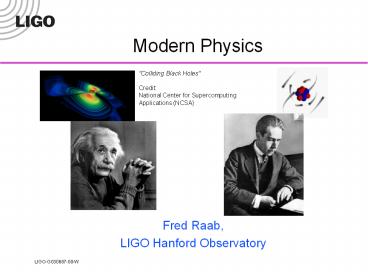Modern Physics - PowerPoint PPT Presentation
Title:
Modern Physics
Description:
Maxwell had shown that electricity and magnetism were different faces of a ... But some riddles remained... LIGO: Tuning into Einstein's Unfinished Symphony. 3 ... – PowerPoint PPT presentation
Number of Views:81
Avg rating:3.0/5.0
Title: Modern Physics
1
Modern Physics
"Colliding Black Holes"CreditNational Center
for Supercomputing Applications (NCSA)
- Fred Raab,
- LIGO Hanford Observatory
2
Physics near the end of the 19th century
- Maxwell had shown that electricity and magnetism
were different faces of a single force - Light was understood to be an electromagnetic
wave and other, invisible electromagnetic waves
were known to be produced by oscillating currents - Gravity was the only other known force
- But some riddles remained
3
Why were there missing colors in sunlight?
- Since Newtons studies of the splitting of light
into a rainbow, or spectrum, scientists were
interested in the study of color and its origins.
Fraunhofer, using exacting techniques to make
high-resolution spectra, discovered many narrow
slices of color were missing from the spectrum of
sunlight. Finding out why this occurred would
lead to the revolutionary advances in 20th
century science.
4
What are stars and how do they shine?
- Annie Jump Cannon studied photographic images of
stars and looked for clues in the colors of
stars. She developed a classification scheme for
stars by color that is still used today and
became crucial to understanding the life cycles
of stars.
5
What is the medium that carries light?
- All other known waves traveled through something,
but light from the stars appeared to move through
empty space - This seemed incredible and it was imagined that
space was suffused with some ethereal medium that
carried light waves, but was so thin it caused no
mechanical drag on planets
6
An important clue, seen as a huge success
- Studying the light given off by elements burned
in flames and by sparks in gases, it was noticed
that the colors came out in sharp slices of
color. Above is the series of visible spectral
lines from hydrogen, named the Balmer series,
after a Swiss high-school chemistry teacher who
worked on spectra.
7
An important clue, seen as a failure
- Albert Michelson, inventor of methods for
ultrahigh precision spectroscopy, and his
chemistry colleague Morley, devise a measurement
to detect the ether. - It failed to detect the ether, even though it was
designed to measure motion of the earth through
the ether to about 10 precision
8
Annus Mirabilis, 1905
- Einstein, age 26, working at Swiss Patent Office
in Bern, published a series of papers that - Laid the foundation for the quantum theory of
light - Ended a millenia-old debate on whether atoms were
real - Introduced a theory of space and time, called
relativity - Discovered the equivalence of matter and energy,
enshrined in the worlds most famous equation,
Emc2. - These papers launched a revolution that led to
most of 20th-century science and technology
9
Rapid progress in quantum theory
- Danish physicist, Neils Bohr produces a model of
the atom that explains the Balmer series of
hydrogen and the stability of matter. It relies
on the fact that, at the atomic scale, the
fundamental particles of matter behave like waves
10
Back in the heavens
- Cecilia Payne, the first woman in America to earn
a Ph.D. in astronomy, argues that the missing
colors in stellar spectra are caused by
absorption by cooler gases in the atmospheres of
stars. Using this realization to study the
composition of stars, she determines that stars
are mostly made from hydrogen and a small amount
of helium







![Modern Physics [2] PowerPoint PPT Presentation](https://s3.amazonaws.com/images.powershow.com/8002705.th0.jpg?_=20160723081)
![L 36 Modern Physics [2] PowerPoint PPT Presentation](https://s3.amazonaws.com/images.powershow.com/7897333.th0.jpg?_=20210302064)

![L 35 Modern Physics [1] PowerPoint PPT Presentation](https://s3.amazonaws.com/images.powershow.com/7552279.th0.jpg?_=20160119094)
![L 37 Modern Physics [3] PowerPoint PPT Presentation](https://s3.amazonaws.com/images.powershow.com/7727835.th0.jpg?_=20160405031)
![L 38 Modern Physics [3] PowerPoint PPT Presentation](https://s3.amazonaws.com/images.powershow.com/8065013.th0.jpg?_=20160820129)
![L 34 Modern Physics [1] PowerPoint PPT Presentation](https://s3.amazonaws.com/images.powershow.com/7125701.th0.jpg?_=20150905079)
![L 33 Modern Physics [1] PowerPoint PPT Presentation](https://s3.amazonaws.com/images.powershow.com/7602675.th0.jpg?_=201602121011)





![Download Book [PDF] Hawley, J: Foundations of Modern Cosmology PowerPoint PPT Presentation](https://s3.amazonaws.com/images.powershow.com/10050367.th0.jpg?_=20240607117)










